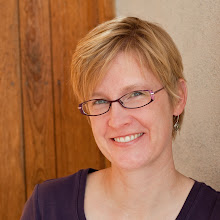 |
| Sarah Swett, Dinner Dazzle (detail) |
I learned not to hold the way you do things too closely. Opening fists clenched tightly around "the way I do it" opened me up for immediate experimentation and, I quickly found, fun. It wasn't really hard to let go. No one could resist entering Sarah's world of imagination... and I'm not much of a closed fist kind of person anyway.
The truth is, there are a million things about tapestry. There are so many ways to go over and under a set of warp threads. So many things we debate--warp, weft, looms, finishing, starting, selvedge technique, tension, image.
Just over and under. Really.
This is some of what Sarah said. But mostly she lives by example.
I want to know what is going to happen and I don't... until I weave it.
Set things up so it is impossible not to do what you really want to be doing.
Try to be really clear.
Start the day as you mean to go on.
Dragonflies are handy that way...
Be consistent.
There is too much information in a photograph.
Jack Lenor Larsen's "unfortunate fringe" might be just the thing.
Try it. (She didn't say that one. But she might have. I think it is what she meant by the whole workshop.)
 |
| Sarah Swett, Cucumber Sandwiches, 14 x 12 inches, hand-woven tapestry, wool, natural dyes |
 |
| Sarah Swett, Scribbles, 14 x 18 inches, hand-woven tapestry, wool, natural dye |
 |
| Sarah Swett, margin notes |
 |
| Cheryl Nachtrieb (Recycled Lamb owner), Sarah Swett (tapestry artist, educator), Barb Brophy (ATA Education Board Chair), Rebecca Mezoff (resident goof) |
 |
| Rebecca Mezoff, workshop sampler |
And yes, as shocking as it is to some of us, she wet finishes them. That means they are washed. In water. Given a bath. Wet. And spun in the washer.
Whew. I'm still trying to open the fists clenched against the weft finishing ...
You can find Sarah's virtual world on her website here: http://www.afieldguidetoneedlework.com/
Now go weave something.










Amazing work, love your sampler. I follow Sarah's website and blog its so entertaining to read.
ReplyDeleteWonderful exciting tapestry all around! Did Sarah happen to mention what breeds she likes to spin for weft?
ReplyDeleteShe did mention it. She talked for quite awhile... amazingly, she likes many different ones. She is committed to local breeders and she mentioned using all of these breeds often in crosses: Romney, Coopworth, Cotswald, Lincoln, Leiscesters, Shetland, Corriedale, Wensleydale, and even Churro. Also Cheviot and Cormo, Targhee, Polworth, Ramboulette mixes... it was a long list and a wide variety. She does look for a long staple for tapestry singles especially for warp. She says for warp she uses mostly pure Coopworth now. I may have some of that wrong, but my impression was that many different breeds will work just fine, especially for weft. Warp is more important to have that long staple so it is strong.
DeleteThank you! Spinning some Lincoln /Corriedale now. Shiney,...... Going to try it in a workshop this weekend in a sampler. Agree about local sourcing. 🌸
DeleteRebecca (resident goof), thank you for sharing your experience at this wonderful workshop. I sure needed to be there. I'm working on a piece with a meandering ribbon line and it's been a real challenge for me to figure out what to do. I have learned a lot thru the process though. I am in awe of Sarah Swett's work, now more than ever. Hearing that she uses her own handspan and even wet finishes her tapestries, wow. Your finished sampler is wonderful, of course. I hope I will always remember that no matter how long we weave tapestries, there's always more to learn.
ReplyDeleteIsn't that true! There IS always more to learn no matter what. Keep playing is my motto.
DeleteThis looks so amazing! Thanks for sharing your experience so we could snatch a glimpse
ReplyDeleteLove hearing about weaving workshops! Found it interesting that Sarah uses a variety of sheep for the weft. I was wondering if she uses a single ply or several singles for the weft.
ReplyDeleteI have tried a single ply of handspun but am now wondering if I should try 3 single plies. My surface did turn out rather fuzzy but more likely from the type of breed used.
By the way, I was reading one of my older Navajo weaving books where they talked about weavers would spin the same warp thread four times which made for a very tight strong warp.
Kirsten
She seems to mostly use two of her handspun singles at once. Her surface is really fuzzy. You can't really see it here, but there is quite a bit of fuzz. It helps soften the look of the piece. Someone at the workshop (might have been Sarah) talked about Navajo weavers using Brown Sheep wool warp (what we used in the workshop), but they respin it to add more twist.
Delete